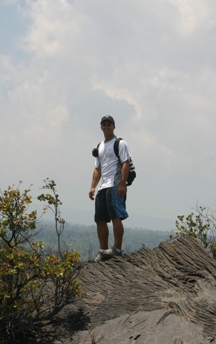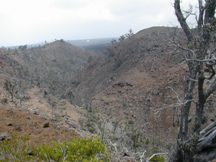Digital Collections
Celebrating the breadth and depth of Hawaiian knowledge. Amplifying Pacific voices of resiliency and hope. Recording the wisdom of past and present to help shape our future.
No‘eau Peralto
All gradutates of the Kamehameha Schools Kea‘au Campus are required to complete a Senior Legacy Project during their twelfth grade year. These projects require students to choose an area of interest, then design and implement a project which serves their community. English writing skills, seminar research skills in an Academy area, and "Ke ‘Ano" character education are all implemented throughout the Legacy Project.
No‘eau Peralto was a member of the first graduating class from Kea‘au Campus. The following is an edited version of the paper he wrote for his seminar course in Science and Natural Resources.
I have spent the last two years doing what most teens my age do: searching for a passion in life. It was not until this spring that I finally stumbled upon a path which few others take—this path led to Hawaiian archaeology. I now have aspirations to become a Hawaiian archaeologist, but I believe it is absolutely necessary that I have an understanding of my Native Hawaiian cultural and spiritual beliefs and protocol in order to succeed. The field of archaeology in Hawai‘i has been a source of turmoil since its inception in the islands, so deciding on the topic of my Senior Legacy Project was simple. I wanted to find a way to coalesce traditional archaeological practices with Native Hawaiian cultural beliefs and protocol.
This is not an issue unique to Hawai‘i; indigenous people all over the globe are faced with similar struggles. It can be described as a clash between cultures. Simply put, archaeology is not and never will be a Hawaiian practice. Sometimes it seems the questions being answered by modern day archaeologists in Hawai‘i are of more concern to Western academia than they are to the Native Hawaiian community.
With archaeology in Hawai‘i becoming increasingly dependent on scientific interpretation alone, sometimes it seems little is gained in reconstructing and enhancing Hawaiian prehistory. Archaeological study done in Hawai‘i has, in most cases, been directed at determining the origins and migratory patterns of Polynesian voyaging peoples. Major concerns of the Native Hawaiian community have been ignored. Many Hawaiians have raised the question: "Why is archaeological study necessary?"
Archaeological work began in Hawai‘i in the late 1800s, but the conflict between Native Hawaiians and archaeologists became more apparent after the mid–1900s, with the onset of excavation work known as intensive archaeology. Although scientists were able to gain a better understanding of prehistoric sites and their age through this practice, in many cases, excavation resulted in site destruction and/or the exhumation of cultural artifacts and human remains.
On multiple occasions, archaeologists and Native Hawaiians have been at odds in regards to the treatment of Native Hawaiian cultural remains and resources. Controversy erupts when such discoveries are made and ". . . the various materials recovered from an excavation along with associated records . . . must be deposited in an institution dedicated to their perpetual care and preservation, usually a museum or university" (Kirch 44–45). Some groups have even expressed that they do not want foreigners who don’t understand their culture meddling with or moving their ancestral remains.
In 1988 at Honokahua, Maui, a private land owner obtained the necessary permits to develop a Ritz Carlton Hotel on Native Hawaiian land. Over 1,000 burials were disturbed during construction, removed, and taken to a lab for examination. The Native Hawaiian descendants of the people buried there were not consulted. Only after months of protest were the ancestral remains repatriated and the burial site restored to its natural state. Despite new laws that state any major development must be approved through the State Historical Preservation Division, an archaeologist, and a Native Hawaiian organization to determine the significance of the site, Honokahua is only one of several instances where Native Hawaiians have been neglected by the system.
The group largely responsible for the repatriation at Honokahua was Hui Mālama i nā Kūpuna o Hawai‘i Nei. Hui Mālama is an organization dedicated to the proper treatment and care of Native Hawaiian cultural resources and ancestral remains. They believe that the bones possess the mana, or spiritual power, of a person and are essential to the continued spiritual health of the Native Hawaiian people. In essence, the desecration of Native Hawaiian ancestral remains could lead to the desecration of the Native Hawaiian people.
The substantial increase of development in Hawai‘i is only one of the many challenges that face Native Hawaiians today—much of what was once sacred land is being intruded upon. In a Western society, archaeology may be the only way we can effectively protect wahi pana (sacred sites) and wahi kūpuna from being destroyed. Development is imminent, but what can be stopped is the destruction of our cultural remains and resources. Archaeologists have the power to protect these sacred sites.
Although archaeology will never be viewed as a "Hawaiian" practice by Native Hawaiians because it is not a part of our culture, caring for our wahi kūpuna certainly is. The time has come to establish a means of archaeological study that is Hawaiian in all aspects—archaeology that addresses the spiritual, cultural, and historical significance of each site, and provides proper protocol in dealing with each.
There is a great need for educating current archaeologists as to the sanctity of ancestral remains. Many foreign archaeologists simply do not understand the spiritual aspects of the Hawaiian culture. To Native Hawaiians, everything has mana. When archaeologists excavate burial sites and remove Hawaiian ancestral remains and artifacts without proper permission, the spiritual balance is disturbed. This causes a disconnection between the physical realm of kānaka and the spiritual realm of our ancestors. Lacking an understanding of this belief, many archaeologists are perceived to be disrespectful and thus destructive in their work.
We as Hawaiians have a responsibility to care for our kūpuna and their remains. One solution is to have more Native Hawaiians involved in archaeology. If more people of a subject group are involved in the archaeological field work dealing with their cultural remains, a greater awareness of the cultural and spiritual beliefs of that people will be instilled on a profession-wide scale. Archaeology must become less of a science and more of a service. Conducted properly, archaeology can benefit the Native Hawaiian people.
A turning point for me was last summer, when I joined one of the archaeologists from the Hawai‘i Volcanoes National Park’s (HVNP) Cultural Resources division on a field study in the Kahuku parcel of the park. The area had never before been archaeologically surveyed and I was intrigued. In preparation for the trip I did a bit of historical research on my own, wanting to learn about the area’s cultural significance. I discovered that Kahuku had been one of the main ruling centers for Keōua, cousin to Kamehameha Pai‘ea, in the late 1700s.
As we explored Pu‘u Ihuanu, I pondered what I had learned about the area in my research, and my mind began to race. I began to see more than "temporary rock shelters"—I saw the remains of my people. I saw the pu‘u as a guardian outpost of sorts, where Keōua possibly posted men to keep watch over his vast lands. While this was only my own hypothesis and may very well have been wrong, I felt a stirring in my na‘au while I stood on that pu‘u and absorbed the works of my ancestors.
I proposed my theory to the archaeologist I was shadowing and, quite frankly, he was blown away. He had no idea that Keōua had resided in Kahuku during his rule in Ka‘ū. Beyond that, he had only a vague idea of who Keōua was! We had found the remains of an ancient civilization—the remains of my people—yet all he had found were stones, because there was an absence of cultural understanding. Something was not right about that picture.
I have since become passionate about learning the culture and history of my people. Although many feel there is a need for archaeological study with an educational objective, how can the cultural beliefs, protocols, and concerns of the Native Hawaiian people be addressed in the process? Common ground must be found between the Native Hawaiian community and the archaeologists who study our past, so we can increase the amount of information about Hawaiian prehistory on our own terms and better protect the wahi pana we know exist today.
Change will only occur if we become the change, and I am committed to the long journey I have begun. I am not only building my legacy, I am perpetuating the legacy of my kūpuna—a legacy that will never die. E ola mau nā kūpuna i loko o kākou.

photo courtesy of: Layne Richards & Noʻeau Peralto
Leon Noʻeau Peralto contributed his Senior Legacy project for Kaʻiwakīloumoku to share with the Hawaiian community.

photo courtesy of: Layne Richards & Noʻeau Peralto
Noʻeau participated in field work which inspired his dream of becoming a Hawaiian archaeologist.

photo courtesy of: Layne Richards & Noʻeau Peralto
Puʻu Ihuanu, in Kahuku, Kaʻū, a power site for Keōua.